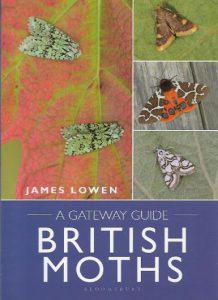British Moths, A Gateway Guide, a field guide to the common moths of Britain and Ireland. 2021. Bloomsbury Wildlife. 224pp. £15.29 on-line. Ring-bound and e-edition available. ISBN 978-1-4729-8738-9 9 781472 987389 A review
My review copy arrived just after the Saharan dust arrived on 16 March 2022 and I had installed the moth trap to see which North African moths had hitched a ride to the UK. So I got out this book and tested the identification. The book is arranged seasonally, that is to say if you are starting to trap moths in 2022 then it begins helpfully with ‘Spring Moths’ – and yes a lot of the moths were present and easy to identify. The author has illustrated pages such as ‘chestnut-brown noctuids’ and ‘beige and reddish-brown noctuids’ and ‘spring-like quakers’. The noctuids are a big and diverse group and there are many overlapping and confusing features thrown in with individual variation, so many of the similar-looking species are a nightmare for moth newcomers. The ring-bound nature of the book is good for use in the field when opening a moth trap and examining species in the presence of fascinated ‘mothers’. Although the UK list of moths is about 2,500 species, this book includes 350 species of the most common and eye-catching species. Some of the common micros are also included. The standard of the close-up photographs is good and the identification features are shown in the photos with precise annotations. James Lowen is already a Bloomsbury Wildlife author who also written ‘Much Ado About Mothing’ (also in 2021). Lowen comes out with some intriguing categories for the ever-confusing noctuids through the seasons, where he calls them ‘Little Brown Jobs’ – referring to the ornithological parlance for difficult avifauna. In comparison, birds are easy to identify, moths are so much more difficult and more appropriate for the epithet. Moths have taken diversity to a completely different level. The whole range of common moths are included from hawk-moths, emeralds, waves, pugs, footmen, tigers, sallows and underwings. At the beginning of the book there is a section on the joy of moths, how to see moths, and how to identify moths. There is a subject index, but no glossary or further information. There are other moth identification books that go into much greater detail, but this is a neat, useful and trap-side identification book in full colour, which is fits nicely into a jacket pocket, and is recommended for all beginners and amateurs who venture into the great world of moths. No, no Saharan moths graced my trap, but many local common moths were present and the book was found to be useful. John Feltwell.
